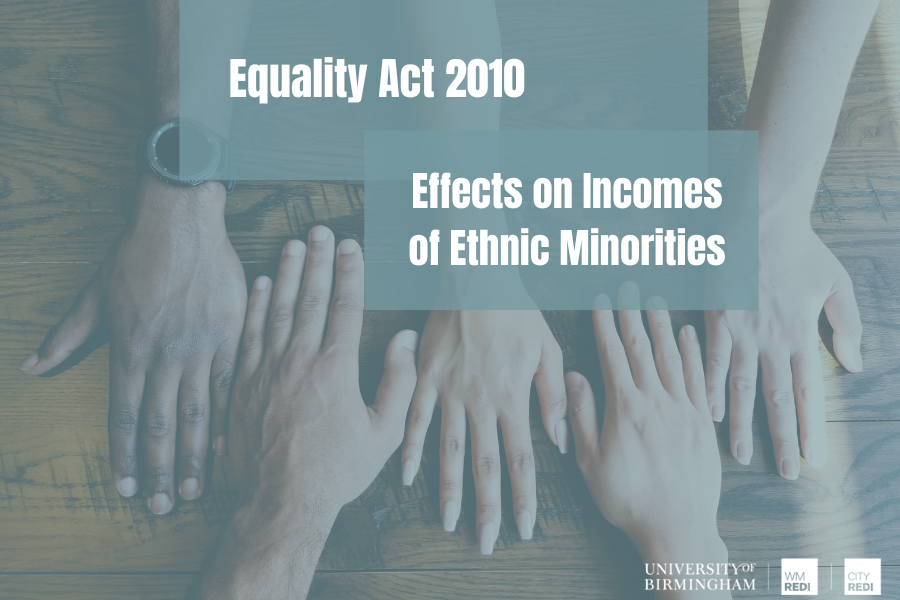
A new report by Maryna Ramcharan looks at the Equality Act 2010 and how the incomes of ethnic minorities changed when the new legislation came into force.
Discrimination in the workplace is a problem for businesses as an individual who is being discriminated against could be under-employed, resulting in a reduced talent pool for the business if they recruit or promote someone who is less able to do the job. At the same time, inequality in the workplace has a negative effect on the social well-being of those who are discriminated against and a much wider effect on the national economy.
According to ONS analysis on pay gaps by ethnicity, many ethnic groups – including Bangladeshi, Pakistani, and Arab ethnic groups – consistently earned less from 2012 to 2019 than those of White British ethnicity over the same time period.
To reduce inequalities in the workplace and protect people from discrimination, the government issued The Equality Act 2010 which states that discrimination or unfair treatment based on certain personal characteristics such as race, age, sex, and others is against the law in almost all cases.
Key findings
- The net monthly income of an average person of an ethnic minority before the Equality Act 2010 was introduced (specifically, in 2009-2010) was 7.07% lower than the incomes of people of any other ethnicity.
- Incomes of ethnic minorities increased on average by 9.53% after the Equality Act was introduced, while the rest of the population saw their incomes increase by 5.33%. This could be attributed to the effect of the Equality Act 2010 under the assumption that the incomes of ethnic minorities and other people did not change at different rates for other reasons.
- Women earned less than men by 21.2%, and people with a degree earned 18.09% more than people without a degree on average, given the same amount of education, ethnicity, gender and occupation.
- Incomes vary greatly between occupations. SOC Major Group 7 “Sales and customer service occupations” earn 51.6% less than managerial positions of Group 1 “Managers, directors and senior officials”, followed by SOC Major Group 9 “Elementary occupations” with a 50.52% income gap with management positions and SOC Major Group 6 “Caring, leisure and other service occupations” with the income gap of 40.73%.
- The estimates of this analysis should be treated with caution as being accompanied by low accuracy and broad confidence intervals being caused by high variability of self-reported data.
Methodology
Pooled Cross Section analysis is based on a natural experiment. A natural experiment occurs when some exogenous event – often a change in government policy – changes the environment in which individuals, families, firms, or cities operate. A natural experiment always has a control group, which is not affected by the policy change, and a treatment group, which is thought to be affected by the policy change. Unlike a true experiment, in which treatment and control groups are randomly and explicitly chosen, the control and treatment groups in natural experiments arise from a particular policy change. To control for systematic differences between the control and treatment groups, we need two time periods of data, one before the policy change and one after the change. Thus, the sample is usefully broken down into four groups:
- the control group before the change,
- the control group after the change,
- the treatment group before the change, and
- the treatment group after the change.
This analysis aims to determine the effects of the Equality Act 2010 on the personal incomes of ethnic minorities and utilises data from the Understanding Society survey to design a pooled cross-section regression model. The hypothesis tested is that the personal incomes of ethnic minority people will rise after Equality Act 2010 because of reduced discrimination they face in workplaces. So, the question examined here is:
Data
As a baseline dataset, we used the Understanding Society Survey, particularly Wave 01 and Wave 03. The choice of waves was determined by the design of the analysis as fieldwork for Wave 01 happened in 2009-10 and reflects the situation before the Equality Act 2010 was introduced while Wave 03 with data collected in 2011-2013 reflects the situation after the Equality Act 2010. The actual regression analysis was run on a subset of Understanding Society survey data which included employed respondents between 16 and 60 years old.

We developed a regression model looking at personal monthly net income, controlling for the following factors that are considered to be influential factors in people’s income:
- Gender. According to the Office for National Statistics (ONS), the median pay for all employees was 15.4% less for women than for men in April 2021. Compared with lower-paid employees, higher earners experienced a much larger difference in hourly pay between the sexes. There is a large difference in the gender pay gap between employees aged 40 years and over and those aged below 40 years. The gender pay gap is higher in every English region than in Wales, Scotland and Northern Ireland
- Degree. Graduate labour market statistics show that 66% of working-age graduates were in high-skilled employment, compared with 78.4% of postgraduates and 24.5% of non-graduates. The median salary for working-age graduates was £35,000 in 2020. This was £9,500 more than non-graduates (£25,500) but £7,000 less than postgraduates (£42,000).
- Occupation. Gross weekly earnings statistics by Office for National Statistics (ONS) show that average (mean) gross weekly earnings vary between occupations from £981 per week for ‘Managers, directors and senior officials’ (Major group 1 of the Standard Occupational Classification (SOC) 2010) to £403 per week for occupations in ‘Caring, leisure and other services (Major group 7 of SOC 2010).
- Region. The dummy variables for geographical regions were used in the model to explore differences in incomes in the West Midlands as the region of interest and London as a salient outlier which may potentially cover part of the variation in regional incomes.
You can view and download the full report on the Income Inequality, Policies and Inclusive Growth project page.
This blog was written by Dr Maryna Ramcharan, Research Fellow, City-REDI / WMREDI, University of Birmingham.
Disclaimer:
The views expressed in this analysis post are those of the authors and not necessarily those of City-REDI / WMREDI or the University of Birmingham.

